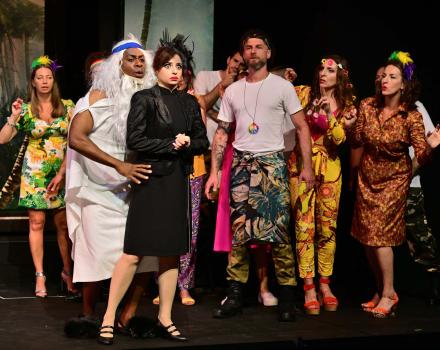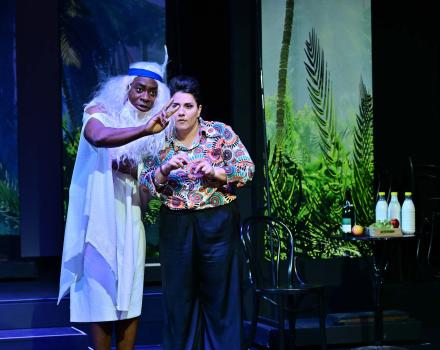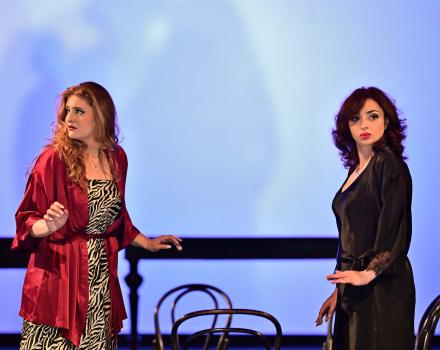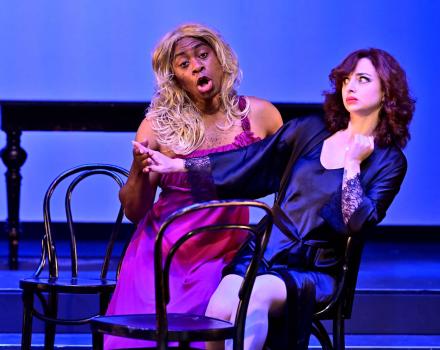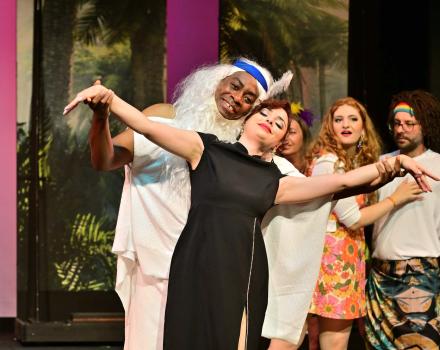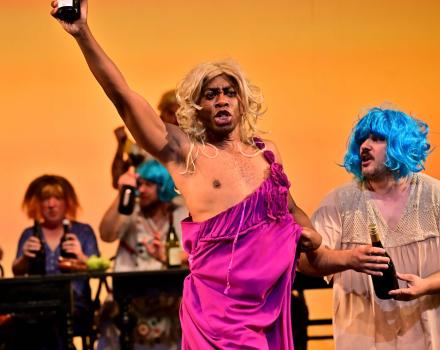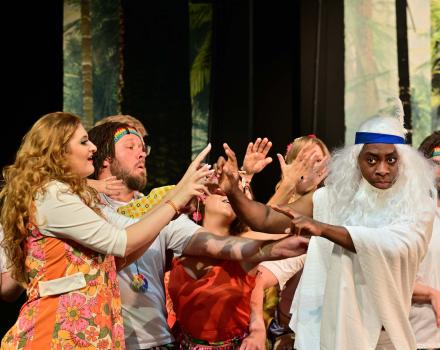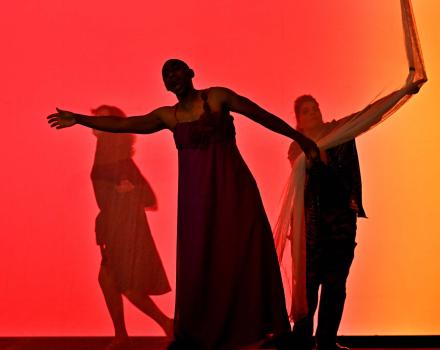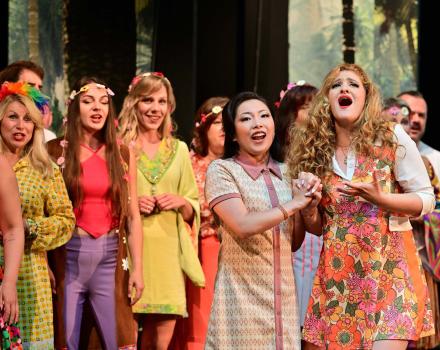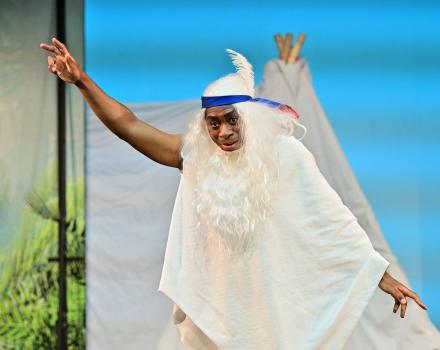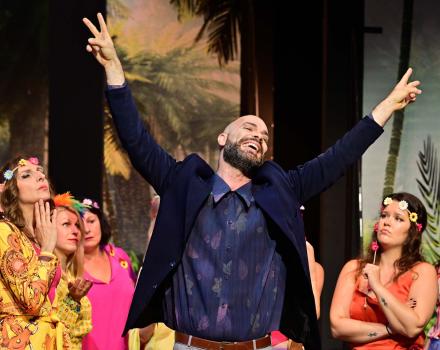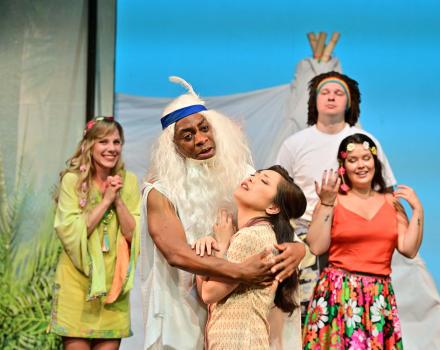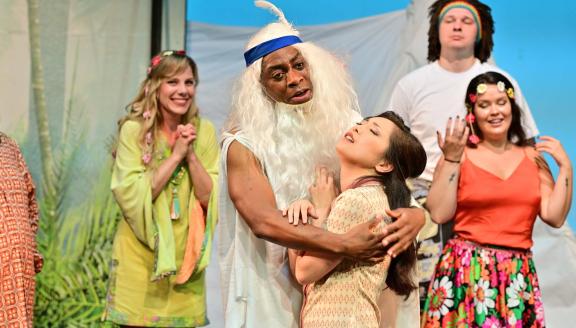
All the men of Touraine are away on a Crusade. Only the young Count and his companions are around but have other things in mind; they are on the prowl for amorous adventures. In ridiculous disguises, they try to outwit the women, for now, bereft of their husbands. The beautiful and strict Countess Adele, to honour her crusading brother and other knights, has taken a vow of chastity, although she has fallen in love with Count’s noble squire, the young Isolier. Surely, in such circumstances, shouldn’t all men be banished from her castle?
So what to make of Rossini’s comedy? Well, it is certainly more than just a collection of old man's jokes. When the Count has finally managed to penetrate the barricaded castle, Isolier appears (who is actually not allowed in either) but has a key role: he unmasks the Count and, in an indescribably beautiful trio, he stands disguised in the dark between him and the Countess to protect her. The Count tries to approach him. But wait! Isolier is not a man at all, it is a woman in travesty. So we have a tenor disguised as a woman who thinks he is making love to a soprano, while in fact he is courting an alto in the role of man who takes the place of the soprano. And what to make of an opera in which a large proportion of the music derives directly from a work whose substance is entirely different, namely, Il viaggio a Reims? There are indeed many questions to address faced with one of Rossini’s most charming and graceful operas. The annual celebration of Rossini in Wildbad in Germany’s Black Forest seeks in their new production to tackle at least one. Who is Isolier? Is the boy Isolier a man or a woman who dreams of being a man, strong like a crusader?
Cast
|
Count Ory
|
Patrick Kabongo
|
|---|---|
|
Countess Adele
|
Sophia Mchedlishvili
|
|
Isolier
|
Diana Haller
|
|
Raimbaud
|
Fabio Capitanucci
|
|
The Tutor
|
Nathanaël Tavernier
|
|
Lady Ragonde
|
Camilla Carol Farias
|
|
Alice
|
Yo Otahara
|
|
Orchestra
|
Karol Szymanowski Philharmonic in Krakow
|
| ... | |
|
Music
|
Gioachino Rossini
|
|---|---|
|
Text
|
Eugène Scribe
Charles-Gaspard Delestre-Poirson
|
|
German translation
|
Reto Müller
|
|
Conductor
|
Antonino Fogliani
|
|
Director & sets
|
Jochen Schönleber
|
|
Costumes
|
Olesja Maurer
|
|
Musical assistant
|
Cécile Restier
|
|
Assistant director
|
Eleonora Calabrò
|
| ... | |
Video
STORY
Act I
In Touraine, at the time of the Crusades, the young Count Ory has gone into hiding with his friends, pretending to be a gifted hermit who can return husbands to women and find husbands for young girls. The women of the village and Ragonde, the Countess of Formoutier's confidante, seek him out. Ragonde hopes that her husband will return from the war in good health and asks for help for the Countess, who is suffering with a heavy heart.
Count Ory's tutor is looking for his runaway pupil, whom he suspects of being here, where there are so many girls. Ory's page, Isolier, loves the Countess, but she refuses him because, like all the other women, she has sworn not to let a man near her until the warriors have returned from Palestine. He asks the hermit, in whom he does not recognise his master and rival, to release the Countess from her vow, as he plans to enter the castle disguised as a pilgrim.
The Countess laments her misfortune and Ory releases her from her vow. Full of joy, she turns to Isolier, but the hermit warns her of the terrible Count Ory. His entry into the castle is thwarted by the tutor, who reveals his true identity to everyone. At the same time, the return of the crusaders is announced. The women rejoice, and the unmasked Ory decides to make the most of the time he has left.
Act II
In the safety of the castle, the Countess, Ragonde and the ladies reaffirm their resistance to Count Ory's advances. During a violent thunderstorm, they hear the voices of pilgrims seeking shelter outside. The Countess gives them shelter and welcomes ‘Sister Colette’, unaware that it is Ory and his companions.
The supposed pilgrims are served milk and fruit, while Raimbaud plunders the wine supply and organises a drinking party. The festivities are interrupted when the Countess arrives to escort the guests to their sleeping quarters.
Isolier is allowed to enter the castle as the vanguard of the returnees from Palestine and reveals the secret of the false pilgrims. He promises to protect his cousin, the Countess, and guards her bedroom. Ory, disguised as ‘Sister Colette’, sneaks into her room to get closer to her, unaware that Isolier has come between them. Erotic confusion ensues; Ory unwittingly sends caresses to Isolier, who passes them on to the Countess.
The return of the crusaders puts an abrupt end to the intimacy. Isolier helps Ory and all the knights to escape.
Insights
Director Jochen Schönleber on Le Comte Ory
Le Comte Ory - What is this opera, which is based on a kind of brutal morality tale in the guise of the Middle Ages? The story of fourteen wild knights disguised as women who find refuge overnight in a nunnery and after nine months fourteen little knights are born, is more than crude. Scribe - no doubt in consultation with the composer - has turned it into a much more finely woven and powerfully condensed libretto, which Rossini transforms into something very special at the height of his musico-dramatic abilities.
The most beautiful piece in the opera, towards which everything builds, is the trio in the second act. It is the dramaturgical climax and at the same time one of the most sophisticated musical numbers in Rossini's entire dramatic oeuvre. I love it.
A woman who has prescribed asceticism for herself while her brother is at war, learns that he will be returning home from the war in an hour. The news is delivered by her admirer Isolier, whom she presumably loves. At the same time, another admirer manages to approach her disguised as a woman.
On the one hand, there is haste, but on the other, the dangerous admirer must be kept at bay. Now she seems more open to love. But which love? It's probably not about the man disguised as a woman. He serves as a pretext. Is it Isolier, the young man sung by a female mezzo? What becomes of this complicated matter? Rossini has created a peculiarly floating, flowing atmosphere. How do I realise this scenically?
I stumbled across this almost unresolvable knot with Diana Haller, with whom I was preparing the role of Isolier. She simply asked: ‘Am I a woman or a man in the piece?’ That's important for the character and for the opera as a whole. I didn't have a clear answer. So I gave the whole thing a prelude in which the plot is hinted at. But with a slight variation, which emphasises the ambiguity.
Comte Ory's introduction is strangely divided into four parts. The introduction is very broken, then comes a march, another reminder of the motif from the introduction and finally the lively prelude, which is well known from Il viaggio a Reims.
In our version, it becomes a parlour game (in Germany called the ‘Trip to Jerusalem’, in english ‘musical chairs’) that ends with the men marching off into the unknown as soldiers, an argument between a carefree man (Ory) and a melancholy woman who is worried about her brother and, yes, what now?
I have slightly twisted the plot in the prelude: Isolier - a female mezzo-soprano in disguise - becomes Isolière, a woman who loves a woman in vain and sees only one chance in the world of men, namely to achieve her goal in the role of a clever young man. This is where she dreams herself into. And this imagination fills the initially empty stage as a game and reinforces the ambiguity of the construction. In the middle this dream becomes a nightmare, where Isolier cannot stop the manipulations by Comte Ory.
All the improbabilities of the Comte's disguise become unimportant and the breaks in the plot hardly play a role any more. The wine-soaked choruses of the disguised knights and the hair-raising reports from Palestine become more bearable as shrill exaggerations.
It is constantly shown that we are only playing the whole thing. We point to the seventies as a time period; back then, gender roles were gradually becoming questionable and there were gurus everywhere, promising ‘easy’ solutions. The stage set consists of mobile elements. First the stage is set up and then emptied again at the end of the act. The trio is transferred to a shadowy world and instead of expensive superstructures there is light. I prefer this kind of imagination to ‘built-in cupboards’. For me this is theatre: a world is created out of nothing for a short while! It takes great actors, soloists and chorus to enjoy the creatio ex nihilo together and I am grateful that I was able to work with such a wonderful team.
Gallery
